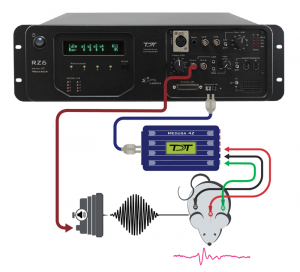![]()
Upcoming Webinars
There are currently no upcoming webinars. Please check back soon!
Recorded Sales Webinars
Introduction to ABRs |

This presentation provides an overview of Auditory Brain Responses (ABRs) and demonstrates TDT’s turnkey ABR hardware and software.
TDT explains how our ABR system leads to easy and robust ABR recordings for high throughput hearing research. Learn best practices for acquiring ABRs and the key things to consider when using TDT’s ABR system.
Integrating Electrophysiology and fMRI |

This webinar discusses TDT’s recent advances in tools for concurrent electrophysiology recordings with fMRI.
Researchers Cherry (Jiayue) Cao (PhD student | PI: Dr. Zhongming Liu | University of Michigan) and Yuncong Ma (PhD student | PI: Dr. Nanyin Zhang | Penn State University) also describe their hands-on experience with the TDT system.
Introduction to Fiber Photometry |

Learn how you can streamline your optogenetic and calcium imaging experiments for studying neural circuits.
The RZ10X and integrated LUX components are discussed as well as the updated Synapse software features. See how the flexibility of the RZ10X results in smoother fiber photometry experiments.
Recorded TDT Talks
Sleep Studies
Dr. Min XuBasal forebrain control of sleep-wake cycle: from neural circuits to sleep homeostasis |
Recorded Webinar
The mammalian basal forebrain (BF) has long been thought to play critical roles in controlling sleep and wakefulness, but the underlying neural mechanisms remain poorly understood. Xu’s team investigated the role of the BF in regulating the sleep-wake cycle using electrophysiology and optogenetic perturbations of the activity of genetically defined cell types and then examined how BF neural activity controls sleep homeostasis. Using a novel adenosine sensor, they uncovered a critical role of the BF glutamatergic neurons in controlling sleep homeostasis.
Dr. Min Xu is a principal investigator in the Institute of Neuroscience, Chinese Academy of Sciences. Dr Xu combines electrophysiology, imaging, and behavioral methods to provide insight into the neural circuits of sleep-wake regulation.
Jimmy Dooley, PhD and Mark Blumberg, PhDMyoclonic twitches during REM sleep drive neural activity in motor thalamus and motor cortex in preweanling rats |
Recorded Webinar
Twitches occur in skeletal muscles across the entire body from infancy through adulthood and are exclusively produced during REM sleep. In rats, Dooley and Blumberg have shown that sensory feedback from these twitches drives neural activity in primary motor cortex (M1) from postnatal day (P) 4 through at least P12. Although twitches are present at later ages, it is not known whether they continue to drive cortical activity. Here, they recorded neural activity in both the forelimb representation of M1 and the motor thalamus in preweanling rats. During that time, REM sleep decreased but neurons in both M1 and motor thalamus continued to show twitch-related activity rats at P12 and P16. Motor thalamus activity lagged the twitches, while at P20, activity in the motor thalamus tracked the twitches with high fidelity. This precise correspondence between twitch-related activity and movements in motor thalamus is an internal representation of a subcortical motor command.
Jimmy Dooley, PhD is a Postdoc in the laboratory of Dr. Mark Blumberg at the University of Iowa, where his research focuses on self-generated movements that drive state-dependent activity in the developing sensorimotor system. Mark Blumberg, PhD is the Department Chair at the University of Iowa. His research focuses on sleep and its development, neural control, and functional significance. His lab uses behavioral, neurophysiological, neuroanatomical, and genetic approaches to help us understand why we sleep so much when we are young and what can go wrong when we don’t.
Hanna Hayat, PhDWhat makes us unresponsive when we sleep? A role for reduced locus coeruleus-noradrenaline activity |
Recorded Webinar
An elevated arousal threshold is a defining feature of sleep, but the underlying mechanisms remain unclear. Using a combination of correlative (units recordings) and causal (optogenetics) approaches, Haya and the Nir Lab investigated the role of the locus-coeruleus norepinephrine activity in mediating sensory-evoked awakenings from sleep.
Hanna Hayat, PhD did her MSc and PhD studies in the laboratory of Prof. Yuval Nir at Tel Aviv University, Sackler School of Medicine. During her PhD, she investigated the mechanisms underlying the reduced responsiveness and the sensory disconnection during sleep. She will start a postdoc position in the lab of Dr. Weizhe Hong (UCLA) in January 2021.
Fiber Photometry
Ted Hsu, PhDUtilization of in vivo fiber photometry to examine the control of need-driven goal-directed behaviors |
Recorded Webinar
To understand how need states (e.g. hunger, thirst) mediates goal-directed behaviors, we expressed protein-based fluorescent sensors in rats to measure, with in vivo fiber photometry, ventral tegmental area (VTA) dopamine neuron activity (Cre-dependent gCaMP in TH-Cre+ rats) or dopamine release (dLight1.2) in the nucleus accumbens shell (NAc shell). We then combined this approach with behavior, chemogenetics, pharmacology, and extensive analyses to elucidate the relationship between the mechanisms that regulate need-states and the mesolimbic dopamine system that subsequently allows for the expression of appropriate goal-directed behaviors.
Philip Jean-Richard-dit-Bressel, PhD and Gavan McNally, PhDMesolimbic dopamine activity signatures of relapse |
Recorded Webinar
We will discuss the use of photometry to map the mesolimbic dopamine signatures of relapse to drug seeking, including the use of representational similarity analysis to overcome the problem of correspondency or mapping between different signals from different sensors and brain regions.
David Barker, PhDUsing a novel photometry modular analysis tool to examine pain responses in the hypothalamus |
Recorded Webinar
The photometry modular analysis tool (pMAT) is a novel graphical user interface used for common types of data analysis in fiber photometry calcium imaging. We will unveil this suite in the present talk and exhibit some data recently collected using the tool which demonstrates a role for the preoptic area of the hypothalamus in pain processing.
Jennifer Rinker, PhD and Patrick Mulholland, PhDPrefrontal cortical (PFC) activation and circuitry during ethanol intake |
Recorded Webinar
Jennifer Rinker, PhD and Patrick Mulholland, PhD of MUSC present their work using fiber photometry to explore prefrontal cortical (PFC) activation and circuitry during ethanol intake.
